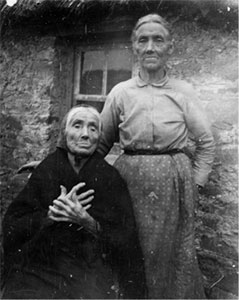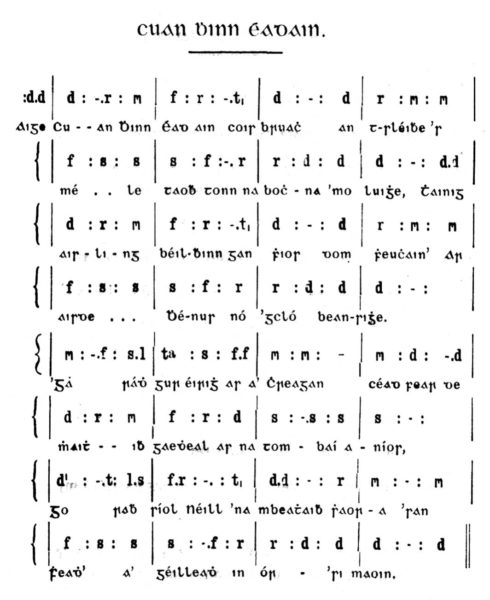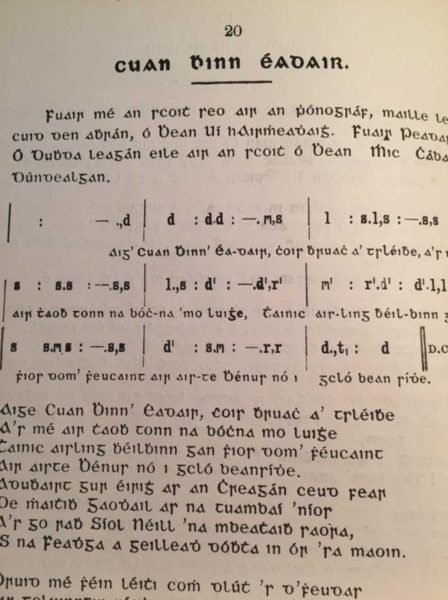Aisling Airt Mhic Cumhaigh
Background
(see A Hidden Ulster pp.273-9 for detailed references and information)

House of Art Mac Cumhaigh in Ballinaghy near Glasdrumman in south Armagh.
The poet, who is in exile, banished and excommunicated publicly by the local parish priest, longs to return to his beloved home place of Ballinaghy now known as Mounthill, near Glasdrumman in south Armagh.
It is another song by the County Armagh poet, Art Mac Cumhaigh (AHU pp. 350-1; pp. 250-84) who is also the composer of songs, Úirchill a’ Chreagain and Mairgne fa Chaisleán na Glasdromainne (Bruach Dhún Réime) on this website. His songs were cherished in the local song tradition and a few survived in the unbroken oral tradition to the present day.
This song was probably written between 1763 and 1767 while the poet Art Mac Cumhaigh was in exile in Howth County Dublin. Following his excommunication from the church, ‘with bell book and candle’ by the local parish priest, Fr Terence Quinn, Mac Cumhaigh found support from the local Protestant minister and his connections – including Lord Howth who employed him as a gardener. His excommunication was due to having married his cousin in a Protestant church. His fractious relationship with the priest was also exacerbated by writing a satire on the priest’s sister because of her miserly and disrespectful reception of him at the priest’s house.
Both were powerful men in their community: Quinn wielded the authority of the Catholic church in the community and Mac Cumhaigh inspired and threatened with the power of the pen. They are both now buried in Creggan graveyard near Crossmaglen.
Oriel Arts © CÉ 2019

Art Mac Cumhaigh’s house near Glasd4rumman.
Transmission

Mary Harvessy and her daughter Mary
The collector Lorcán Ó Muirí (AHU pp.358-60) wrote down a version from Mrs Mary Harvessy (AHU pp. 391-20) of Clonalig, Crossmaglen, who was born around 1830 (57 years after the poet’s death) and claimed kinship with the poet on her father’s side. She had learned her songs from her mother and grandmother, which included at least four songs by Mac Cumhaigh. It is likely that her version (below) came directly from the poet himself who died in 1773.
Lillis Ó Laoire, the singer here, learned his version from a recording of Armagh singer Gerry Hicks. It is not known where Gerry Hicks got this version but it is based on the version collected from Mrs Harvessy. Hicks was a close friend of collector Sean Ó Baoill (AHU pp.379-81) who collaborated with singer Aodh Ó Duibheannaigh (Hiúdaí Phadaí Hiúdaí) from Rannafast, County Donegal and was known to make creative changes and additions to melodies (AHU p. 257). It is likely that the melody, written down from Mrs Mary Harvessy and published by Lorcán Ó Muirí ,was creatively changed by Ó Duibheannaigh and Ó Baoill. Lillis informs us that he added to these creative changes and made it his own.

Lillis Ó Laoire & Pádraigín Ní Uallacháín. Photo M.Ó Graham
There has been a long close connection between the Donegal Gaeltacht and Oriel. The dialect is very similar and songs have been exchanged back and forth for centuries. That relationship continues, and Lillis Ó Laoire was invited by ORIEL ARTS PROJECT to record on video, one of Art Mac Cumhaigh’s songs which he had in his repertoire. It was filmed in An Mullach Bán June 2016.
Oriel Arts © Ceoltaí Éireann 2018
Words
Sources:
- ‘Aisling Airt Mhic Cumhaigh’, T. Ó Fiaich, Art Mac Cumhaigh – Dánta 1973, p.111. (8 verses).
- ‘Cuan Bhinn Éadair‘ p.20 – Amhráin Chúige Uladh, 1927 from Mary Harvessey (8 verses).
Aisling Airt Mhic Cumhaigh
Ag cuan Bhinn Éadair chois bhruach na hÉireann,
Is mé ar thaobh tonn na bochna ’mo luí,
Thainig aisling bhéilbhinn gan fhios do m’fhéachaint
Ar aiste Venus nó i gcló bean sí,
A dúirt gur éirigh as an Chreagán céad fear
De mhaithibh Gael as na tuambaibh aníos,
Is go raibh Síol Néill ina mbeathaibh saora
Is an Feadha ag géilleadh dóibh in ór ’s i maoin.
Dhruid mé léithe chomh dlúth is d’fhéadas
Ar gcluinstin réim cheart na cóige thíos;
Agus d’fiafraíos féin di an raibh mac Éinrí
Ag cur na cloiche réime úd in ordú arís(t)?
Nó ar chúrsaí tréas é in aghaidh na dtréanfhear
Coill(idh) Dhún Réimhe bheith dóite i ngrís;
Nó ’r bhfios don mhaighdean bhí ’g ársaí scéil domh
An raibh Eoghan Ó Néill mac Airt Óig sa tír?
Tá fós an Phoenix róbheo in éifeacht
Foradh an aoibhil nár feochadh nár faobhadh;
Caitlín réimiúil níon Eoghain na féile
A mbíodh ór is éifeacht na Fodhla ’na maoin;
As brollach Néill Fhrasaigh amach gan claon í,
A raibh na ceatha daonnacht’ ag dortadh ’na chroí,
An míleadh tréitheach de mhaithibh Éireann
Sliocht Cholla an dea-chroí dár fhóir an dá chrích.
’Sé dúirt an neamhainn gur tráth damh éirí,
Is cónaí a dhéanamh fán Chreagán thíos,
Mar a raibh an tAthair Féilim arís in éifeacht
Ag teagasc daonnacht’ mar chóir don tír;
Mar a bhfaighinnse léaghsaí ar fhearann saor ann
Ag cumadh véarsaí go ceolmhar caoin,
’S nárbh fhiú damh éalú i dtír ó chéile
Fán chloigín bhuartha ’bhí i ndorn mhic Naois.
Tá mo chroí-se réabtha ’na mhíle céad chuid,
’S gan balsam féin ann a d’fhóirfeadh dom phian;
Nuair a chluinim an Ghaelig uilig dá tréigbheáil(t)
Agus caismirt Bhéarla i mbéal gach aoin,
Bhullaí is Jane ag glacadh léaghsaí
Ar dhúichí Éireann na n-órbhall caoin;
’S nuair a fhiafraím scéala ’sé an freagra ’ghéibhim:
‘You’re a papist, I know not thee.’
Clisim féin as an chodladh céanna
Mar dhéanfadh cladhaire bheadh seal ’na luí;
Nó mar Oisín faonlag ’bhí ag taisteal Éireann,
Nuair a cailleadh an Fhéinn aige mórchath na maoidhm.
In áit a bheith ar thaobh chnoic i bhFeadh na féile
Mar a ndéanainn céilí is cónaí faoi aoibh,
’Sé fuair mé an méid sin i nglasaibh daora
Is Bhullaí ag méidhligh mar leon le m’ thaobh.
Art MacCooey’s Dream
At the harbour of Howth by the shores of Ireland
And I lying by the rolling sea,
A sweet-spoken vision came, unknown, to see me,
Resembling Venus or some banshee,
Who said a hundred men arose from Creggan
Of the finest Gaels from the tombs beneath,
And that the heirs of Ó Néill were in noble holding
With the Fews paying homage in gold and gifts.
I drew near to her, as close as I could,
On hearing the true line in the province below,
And I asked her myself was the son of Enrí
Restoring the seat of power once more?
Or was it a case of treason against the valiant men
To have the woods of Dunreavy a burning glow,
Or could the maiden, who was bringing this news, tell me
Was Eoghan son of Art Óg Ó Néill now home?
The Phoenix is much alive and in full vigour;
The spark of fire never went out or died;
The mighty Caitlín, daughter of generous Eoghan
Who once had Ireland’s wealth and wisdom in kind;
Faultless and from the lineage of Niall Frasach,
Showers of humanity in his heart flowed;
The skilful hero of Ireland’s finest,
The race of kind Colla, the two lands did support.
This vision said, it was time to rise
And go to live in Creggan then,
Friar Féilim was reinstated,
Teaching humanities as he aught again;
Where I would get lease on a freehold there,
Composing songs of sweet tender verse,
And I had no need to flee the country
For the troubled bell in the son of Naoise’s fist.
My heart is torn in ten thousand pieces
And no healing balsam to sooth my grief;
When I hear Irish all forsaken
And a clamour of English in every mouth;
Willie and Jane taking leases
In the land of Ireland’s fair golden fields,
And when I seek news, the answer I’m given:
‘You’re a papist, I know not thee.’
I’m startled out of this same slumber
As a waistrel would, who was awhile asleep,
Or as feebled Oisín traversing Ireland
When the Fianna were routed in the great defeat.
Instead of on a hillside in the friendly Fews
Where I would céilí and live at ease;
I heard all this in sore oppression
And Billy bleating like a lion by me.
(Translation: P. Ní Uallacháin)
Oriel Arts © Ceoltaí Éireann 2018
Music

‘Cuan Bhinn Éadain’ p.22 Amhráin Chúige Uladh 1927 collected by Peadar Ó Dubhda from Mrs.MacCabe, James St., Dundalk colleted c.1906. Also, AHU p.277.

Mrs McCabe from Mullaghban living in James St Dundalk c. 1912
Peadar Ó Dubhda (AHU pp.170-2), one of the few collectors who was musically literate, collected songs at the turn of the 20th century and he wrote down the air of a version he heard from Mrs McCabe (AHU p. 409) of Dundalk. It is a more polished air and might well have been developed or composed by Peadar Ó Dubhda, who was known to submit airs as traditional but were composed by himself as a way of getting them published (AHU p 236).
This next version was collected by Lorcán Ó Muirí from Mrs Mary Harvessy, Clonalig,, Crossmaglen and also published in tonic solfa in his collection Amhráín Chúige Uladh, 1927. It has a simpler more recitative type air which suits the narrative in the lyrics, and is an example of older type narrative airs. It is in two long melodic AB phrases. It was later edited by Colm Ó Baoill and published in staff notation in a new edition 1977. The version sung by Lillis ó Laoire and transmitted by Armagh singer Gerry Hicks, is based on this melody.

Mrs Mary Harvessy version collected by Lorcán Ó Muirí c 1912 and published in Amhráin Chúige Uladh 1927.

Mrs Mary Harvessy version in staff notation. Amhráín Chúige Uladh, ed. Dr Colm ó Baoill, 1977.
